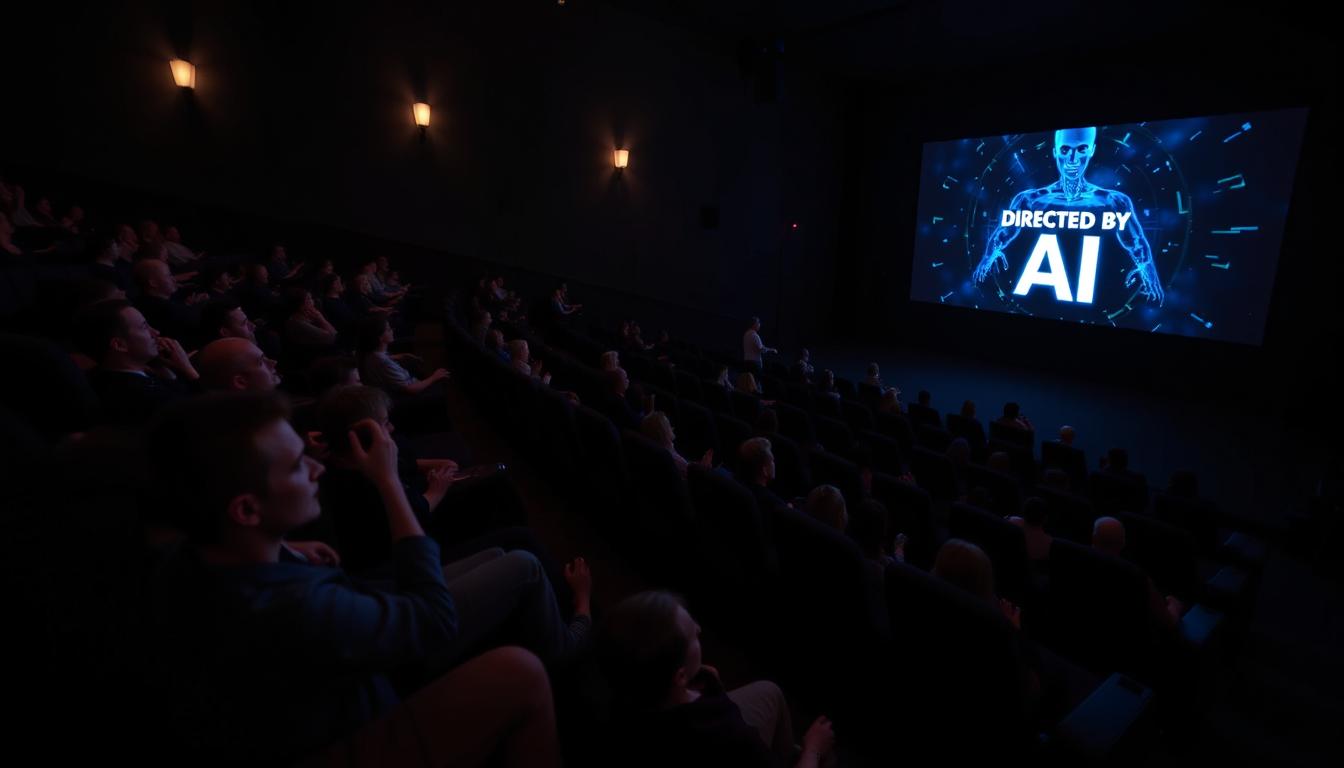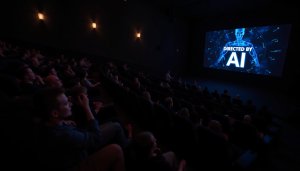Cinema and Technology: How AI Is Rewriting Both Scripts
One of the most striking developments of recent years is how quickly artificial intelligence has become omnipresent. It’s no longer confined to labs or niche applications. It’s just everywhere. From customer service chatbots to productivity tools, from social media algorithms to healthcare diagnostics, AI is a part of our daily lives. And in one of the most emotionally spaces for me, Cinema, it’s beginning to not just assist the process but actively shape it.
Interestingly, this evolution in cinema runs parallel to what we’ve seen in the tech world. The roles of designers, developers, and creatives are being redefined by AI tools. The same thing is happening in film. The creative, technical, and collaborative roles that once defined the movie-making process are being questioned, challenged, and, in some cases, replaced.
This article takes a closer look at how AI is changing cinema, based on firsthand experiences at the Avanca Film Festival, and draws clear connections with what’s happening in the wider tech ecosystem. As we navigate this shift, we must ask ourselves: is AI just another tool, or is it redefining what it means to create?
If you want to read my take focused in Cinema, you can go to Antestreia (in Portuguese)
The Early Tools: From Assistants to Accelerators
In both cinema and technology, AI started as an assistant. Just a tool meant to speed things up, make life easier, and fill in the tedious gaps. In filmmaking, early use cases were small but impactful: changing an actor’s age through deepfake technology, subtly altering lip movements in dubbed scenes to match the new language. These applications didn’t fundamentally alter the creative process; they enhanced it.
In the tech world, the analogy is straightforward. Just as film editors used AI to clean up audio or enhance visuals, software developers started using AI to autocomplete code, debug functions, or test systems. Designers began leveraging AI to generate color palettes or suggest layouts. These were productivity boosters, not creators.
At this stage, AI was not seen as a threat. It wasn’t trying to be the director, screenwriter, or actor. It was more like an intern. Competent at some tasks, needing supervision, but not setting the vision.
That stage didn’t last long.
The Festival Experience: Glimpses of the AI Future
At the Avanca Film Festival, the creation of a new category for AI-generated films offered a unique window into how filmmakers around the world are using (and misusing) AI. I had the chance to watch 19 films created with varying degrees of artificial intelligence. Some were thoughtful and creative. Others felt like rushed experiments, showing more about what AI can do than what it should do.
This mirrored what we often see in the tech landscape during early adoption phases. A new tool appears, and a wave of crappy projects follows. The barrier to entry is lowered, but so is the average quality.
The same is happening in cinema.
The Minimal Use: AI as Enabler of Expression
One film particularly stood out for its nuanced use of AI. It featured a physically limited character who used AI to create videos of herself dancing. This allowed the character to live a fuller life online with an identity that complemented their real-life experience. It wasn’t about deception, but expression. It felt therapeutic, purposeful, and creatively valid. And the audience, followers who know the author, cheered the new virtual life.
This is the equivalent of someone with no programming knowledge using AI to build a functioning app to solve a personal problem. It’s not revolutionary in form, but it is in accessibility. AI, in this case, was a bridge between vision and execution. It enabled someone with limited technical knowledge means to share a new side of themselves with the world.
In tech, we often talk about democratization. Many platforms have made app development accessible to non-programmers. AI is taking that further, enabling voice interfaces, automatic translations, and app prototypes from simple prompts.
In both domains, AI is not replacing the creator. It’s allowing skilled people to create more with less time and money.
The Lazy Use: AI Without Vision
Unfortunately, not all films at the festival were thoughtful. Several projects had scripts written entirely by AI, scenes generated by prompts, and visuals created without real editing or coherence. The result? Dull, soulless works that felt like horrible demos of AI capabilites. They lacked rhythm, emotion, and structure. Watching them was like reading pages of unedited ChatGPT output: apparently it is technically correct, but void in appeal.
This recalls a growing concern in the tech space: the proliferation of AI-generated content with no clear purpose. Spammy SEO articles, auto-generated eBooks, clickbait apps that replicate existing functionality… all examples of AI being used without vision or oversight. Just because you can generate something doesn’t mean it’s worth consuming.
We’ve all seen product landing pages made in 30 seconds, AI influencers who post content generated by LLMs, or AI-generated code that no one understands or maintains. The result is noise and it’s getting louder.
In both cinema and tech, the message is clear: automation without intention is a dead end. It is scaring the audience away from the skilled creators.
The Abusive Use: Tech Bros With Movie Scripts
Some of the films were even worse. They were projects that felt like someone had discovered a toy, played with it for an afternoon, and then expected applause. These films weren’t driven by a desire to say something or explore a concept; they were a parade of gimmicks. It’s the cinematic equivalent of tech bros with a broken MVP and calling themselves visionaries at a magazine cover.
These creators mistake novelty for value. In tech, these are the startups that chase trends without solving real problems. In cinema, it’s filmmakers who confuse AI’s output with their own voice.
Here, the danger isn’t just about low quality. It’s about their ego. These creators demand recognition, not for what they’ve crafted, but for the tool they’ve used. It’s like someone bragging that their entire website was built by AI and assuming that makes them a product designer.
They are bad at it and others will think “I can also do this” escalating the issue exponentially.
Tools don’t make artists. They never did.
The Clever Use: Art With Intent
And yet, amidst the noise, there were truly clever uses of AI. Films that used the technology as a medium rather than a crutch. One striking example was a short animated film that presented disfigured animal characters. At first glance, the visuals felt odd, even off-putting. But then the theme became clear: environmental degradation. The strange appearance of the animals was a warning, a mirror of human impact on nature and discomfort was necessary.
The film’s message was strong, the execution consistent, and AI was used to accelerate instead of dominate the process. This mirrors how tech teams are starting to use AI in more sophisticated ways: not to replace, but to amplify. Whether it’s generating synthetic data for training, enhancing user research, or assisting in accessibility design, AI is becoming a collaborator. Not the boss. Not the full team.
In both cinema and tech, the future lies in thoughtful integration. Where the artist or developer still holds the steering wheel, and AI is part of the engine.
The Bold Experiment: A Glimpse Into Tomorrow
The most interesting piece at the festival was an experimental English short film, around seven minutes long. Nearly every frame had been generated by AI, yet it flowed with narrative coherence and emotional resonance. It didn’t feel artificial. It felt like a person using AI to push past the limits of budget and manpower, not delegating creativity.
This is the kind of use we celebrate in the startup world. A solo founder using AI to build a full product demo. A designer prototyping a full UX experience in a weekend. A marketing team creating personalized campaigns at scale. It’s not about AI doing everything. It’s about humans doing more with AI.
In cinema, this approach could soon redefine indie filmmaking. A single creator can now ideate, visualize, and iterate without needing a massive team or studio backing. It doesn’t mean the death of traditional filmmaking – just as AI in tech doesn’t kill human jobs – but it will change the scope of what individuals can achieve.
The Inevitable Shift: What the Future Holds
So what happens next?
If we’re alarmist, we predict mass job losses – from visual effects artists to editors to storyboard designers. The same fear is present in tech: copywriters, junior coders, QA testers – all potentially made redundant by increasingly capable AI tools.
If we’re optimistic, we see a future where AI acts as a multiplier. Where more people get to bring their stories, their visions, and their problems to life. Where someone with an idea for a sci-fi epic or an app for elderly care can finally execute, not just dream.
Both views are valid — and both are happening simultaneously.
But the real transformation will be cultural. Just as photography went from elite art to key life moments to thousands of daily selfies, cinema is now entering a phase where the tools of storytelling are accessible to nearly everyone. The internet, AI, and streaming platforms will flood the market with content. Some of it will be extraordinary. Most of it will be trash.
That’s why curation matters. Festivals, platforms, and communities will play a crucial role in filtering signal from noise both in tech and in film. Algorithms alone won’t be enough. Human taste, context, and values must guide the way forward.
Conclusion: AI as Medium, Not Master
AI is here. In cinema, in tech, in life. But we’re still deciding how to use it. At its best, it’s a tool of inclusion, acceleration, and empowerment. At its worst, it’s a generator of noise, ego, and distraction. And misinformation where we used to have knowledge.
The parallel between the film industry and the tech world is clear: AI will not make creators irrelevant. It will force them to be more intentional. The bar for entry may be lower, but the bar for impact is higher. In both spaces, the ones who will thrive are those who treat AI not as the artist, but as the brush.
Art still needs an eye. Vision still needs a voice. And against all our instincts, technology still needs a human touch.


Post Comment